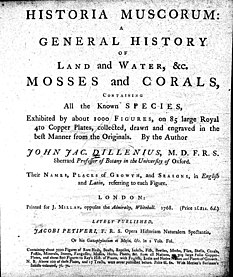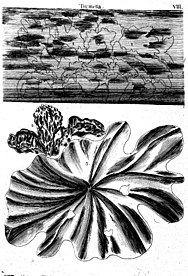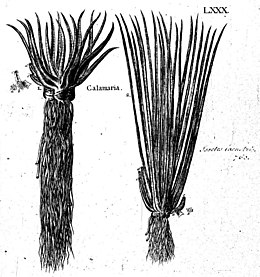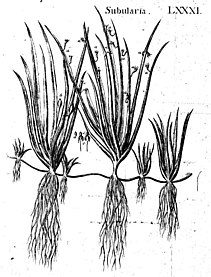Johann Jacob Dillenius
Johann Jacob Dillenius | |
|---|---|
Oxford University | |
| Author abbrev. (botany) | Dill. |
Johann Jacob Dillen Dillenius (1684 – 2 April 1747) was a German
.Biography
Dillenius was born at Darmstadt and was educated at the University of Giessen, earlier the family name had been changed from Dillen to Dillenius. In 1721, at the instance of the botanist William Sherard (1659–1728), he moved to England. In 1734 Dillenius was appointed Sherardian professor of botany at Oxford, in accordance with the will of Sherard, who at his death in 1728 left the university £3000 for the endowment of the chair, as well as his library and herbarium,[1] all on the condition that Dillenius should be appointed the first professor.[2]
Dillenius died at Oxford, of
Work
At Giessen Dillenius wrote botanical papers for the Ephemerides naturae curiosorum. He printed, in 1719, his flora of the university's surroundings, a Catalogus plantarum sponte circa Gissam nascentium, illustrated with figures he had personally drawn and engraved, with descriptions of several new species.[1]
In 1724 Dillenius published the third edition of John Ray's Synopsis Methodica Stirpium Britannicarum. It incorporated plant species discovered by Samuel Brewer, and work on mosses by Adam Buddle.[3][4] It remained a standard reference for British botanists until the appearance of Carl Linnaeus's Species Plantarum in 1761.
Hortus Elthamensis
In 1732 he published Hortus Elthamensis,
-
Title page of Hortus Elthamensis, 1732
Historia muscorum
Dillenius wrote Historia muscorum (1741), a natural history of lower plants including
- Sample of plates with original titles (and notes)
-
Title page, 1768 edition
-
6 Conferva
-
8 Tremella
-
11 Usnea (beard lichens)
-
14 Coralloides (cup lichens)
-
18 Lichenoides (crustose lichens)
-
32 Sphagnum (bog moss)
-
38 Hypnum
-
46 Bryum
-
56 Selago
-
59 Lycopodium
-
76 Lichen (liverworts)
-
79 Pilularia
-
80 Calamaria
-
81 Subularia
Honours
In 1753, Carl Linnaeus in his Species Plantarum published Dillenia, a genus of flowering plants in the family Dilleniaceae, native to tropical and subtropical regions of southern Asia, Australasia, and the Indian Ocean islands, both genus and family named in Dillenius's honour.[12]
In 1997, the Spanish botanist Gerardo Antonio Aymard Corredor published Neodillenia, a genus of flowering plants from South America belonging to the family Dilleniaceae, named in Dillenius's honour.[13]
Selected publications
- Dillenius, Johann Jakob (1732). Hortus Elthamensis, seu Plantarum rariorum, quas in horto suo Elthami in Cantio coluit ... Jacobus Sherard ... Guilielmi ... frater delineationes et descriptiones. London: Sumptibus auctoris. Archived from the originalon 4 March 2016. Retrieved 26 July 2015.
- also on Gallica
- also on
- [Synopsis of British plants] (in Latin) (3rd ed.). London: Gulielmi & Joaniis Innys.
- Facsimile edition 1973 Archived 20 March 2017 at the ISBN 978-0-903874-00-7
- Facsimile edition 1973 Archived 20 March 2017 at the
- Dillenius, John Jac. (1768). Historia Muscorum: A General History of Land and Water, &c. Mosses and Corals, Containing All the Known Species, Exhibited by about 1000 Figures, on 85 large Royal 4to Copper Plates, collected, drawn and engraved in the best Manner from the Originals. Opposite the Admiralty, Whitehall, London: J. Millan.
References
- ^ a b c d e One or more of the preceding sentences incorporates text from a publication now in the public domain: Chisholm, Hugh, ed. (1911). "Dillen, Johann Jakob". Encyclopædia Britannica. Vol. 8 (11th ed.). Cambridge University Press. p. 272.
- ^ Stephen, Leslie, ed. (1888). . Dictionary of National Biography. Vol. 15. London: Smith, Elder & Co. p. 79.
- doi:10.1093/ref:odnb/3366. (Subscription or UK public library membershiprequired.)
- doi:10.1093/ref:odnb/3883. (Subscription or UK public library membershiprequired.)
- ^ Dillenius 1732.
- ^ JSTOR 42792377.
- ^ Arora, Nikita (3 November 2022). "The many meanings of moss". The Guardian. Retrieved 3 November 2022.
- ISBN 978-0-415-32681-0.
- ^ "Historia Muscorum". Oxford Herbaria, Department of Plant Sciences, University of Oxford. Retrieved 3 November 2022.
- doi:10.1093/ref:odnb/7419. (Subscription or UK public library membershiprequired.)
- doi:10.1093/ref:odnb/7648. (Subscription or UK public library membershiprequired.)
- Saint Louis, Missouri: Missouri Botanical Garden. Retrieved 20 February 2010.
Type Specimens: Dillenia indica
- ^ "Neodillenia Aymard". Plants of the World Online: Kew Science. Retrieved 27 May 2021.
- ^ International Plant Names Index. Dill.

















